Perfect Basmati Rice in a Rice Cooker (White and Brown)
Perfect Basmati rice made in a rice cooker! Make basmati rice in the Indian and Pakistani style without the soaking, monitoring, or temperature adjustments. This recipe shares the perfect ratios for fluffy, moist, separated basmati rice kernels that’ll get compliments every time!
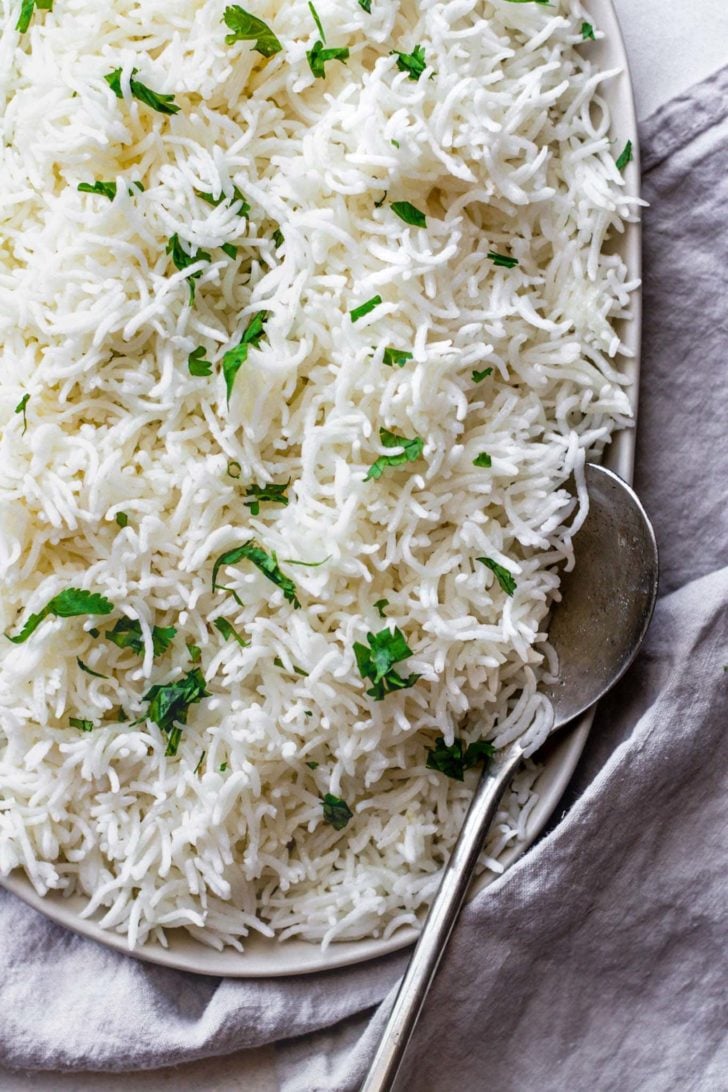
Want to save this post?
Enter your email below and get it sent straight to your inbox. Plus, get recipes & tips every week!
“I’ve been making basmati rice in my rice cooker for years and this is the first time it’s ever come out perfect. Literally every grain.”
Julia
I’m a little hesitant to share this ‘non-recipe’, but in my defense, this is less a recipe and more a call for everyone reading this to invest in a rice cooker.
Here’s the thing – We can all make wonderful basmati rice without a rice cooker, but the idea is to do so consistently with no thought or effort on our part.
Indian and Pakistani cuisine is full of delicious rice dishes such as biryani and pulao. Considering how frequently South Asians consume rice, I think rice cookers are a necessity. And I’ll show you how to use them to make the perfect basmati rice, every time.
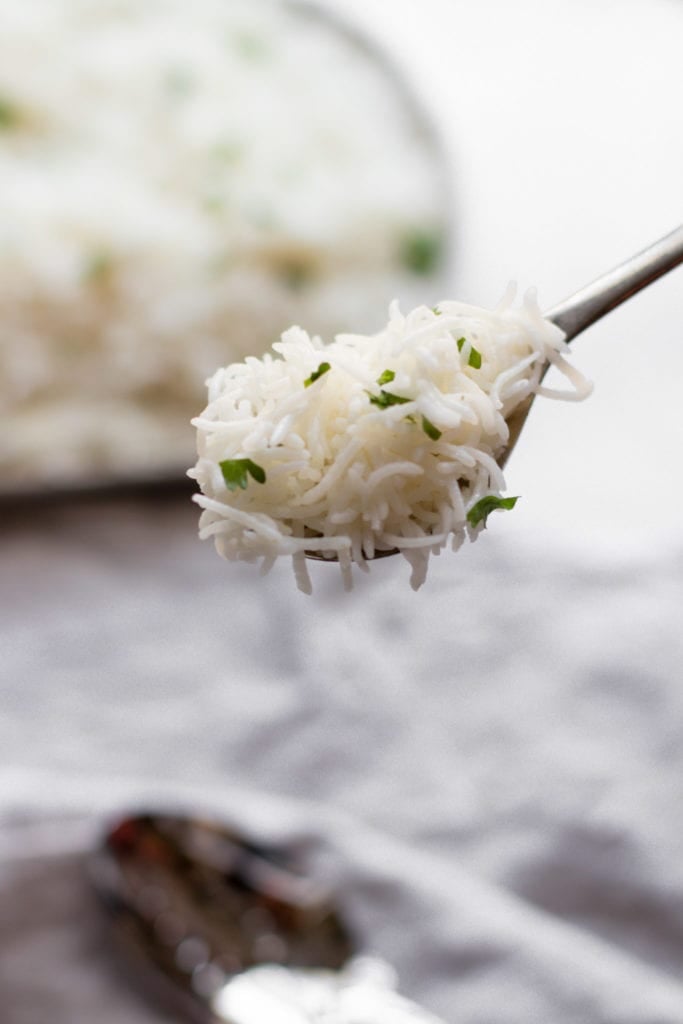
The 3 Mistakes that Result in ‘Okay’ Rice:
- Not adding enough water. Aged, long grain basmati rice needs more liquid than other types of basmati rice. You want it to be firm, each kernel separate, but soft enough to break easily between your fingers.
- Not adding salt. Not adding salt to rice is the equivalent of not adding salt while boiling pasta.
- Not adding fat. Adding just a tad bit of oil (any kind) or butter will enhance the rice and give it a moist finish, making it the perfect canvas for curries.
Ingredients for Basmati Rice in a Rice Cooker
Here’s what you’ll need.
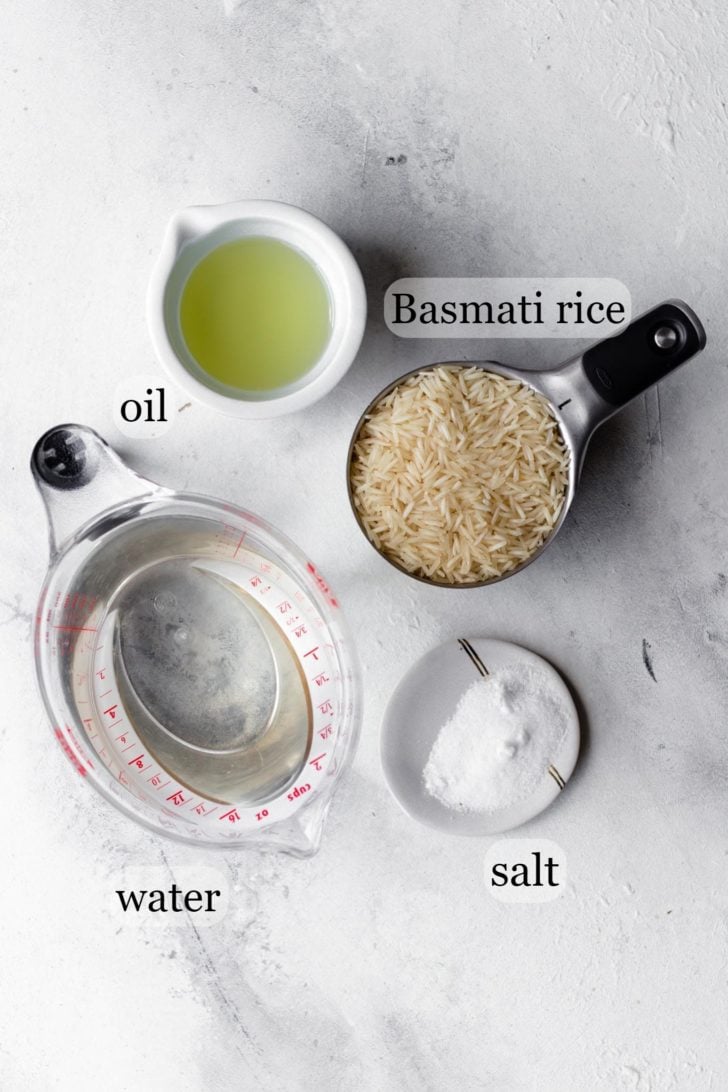
- Basmati rice, preferably aged and long grain.
- Water.
- Oil. Optional, but lovely. You can use olive oil or a more neutral-tasting oil, but you can hardly tell the difference.
- Salt.
What Is the Basmati Rice To Water Ratio In A Rice Cooker?
This depends on the type of rice you have, particularly if it’s aged or newly harvested. If you use aged, long grain basmati rice made in India or Pakistan, you’ll need 2 cups of water per 1 cup of rice. If you’re using American-made or ‘newer’ basmati rice, try reducing the amount of water to 1 3/4 cups.
How to Make Basmati Rice in a Rice cooker
Do you Have to Rinse Basmati Rice when Making it in a Rice Cooker?
The dreaded answer – it depends. You don’t absolutely have to, but it is a good idea in most cases. Excess starch in rice causes cooked rice to clump together which is not what you want with basmati rice.
- If you’re using newer basmati rice found in American supermarkets (shorter grain, more white), then you can do without rinsing.
- But aged, long-grain basmati rice (longer grain, more ivory-colored) is sometimes excessively starchy. Ideally, you should rinse it. (That said, when in a hurry, I’ve made 1 cup of rice plenty of times without rinsing and no one has complained.)
- Rinsing is especially important if you’re making multiple cups of rice because the starch can really add up.
Tip for rinsing: When you rinse, make sure to drain the excess water out well so you don’t end up with mushy rice because of too much water.
The Steps:
- Add the rice, water, oil, and salt to the rice cooker and stir to combine.
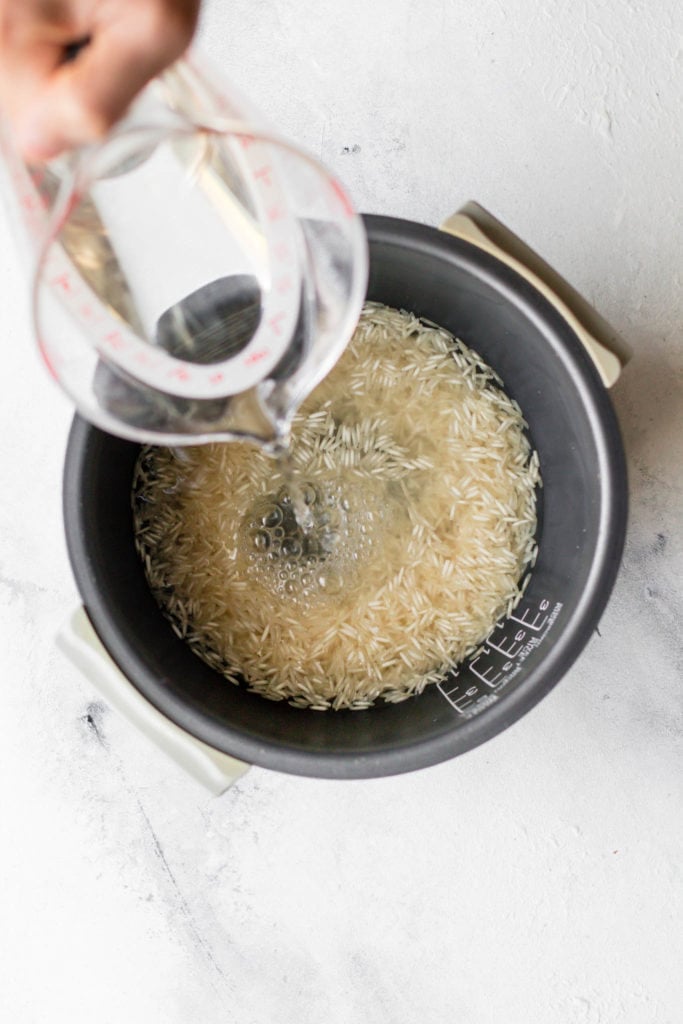
- Choose Normal (Regular/Sushi) Rice setting.
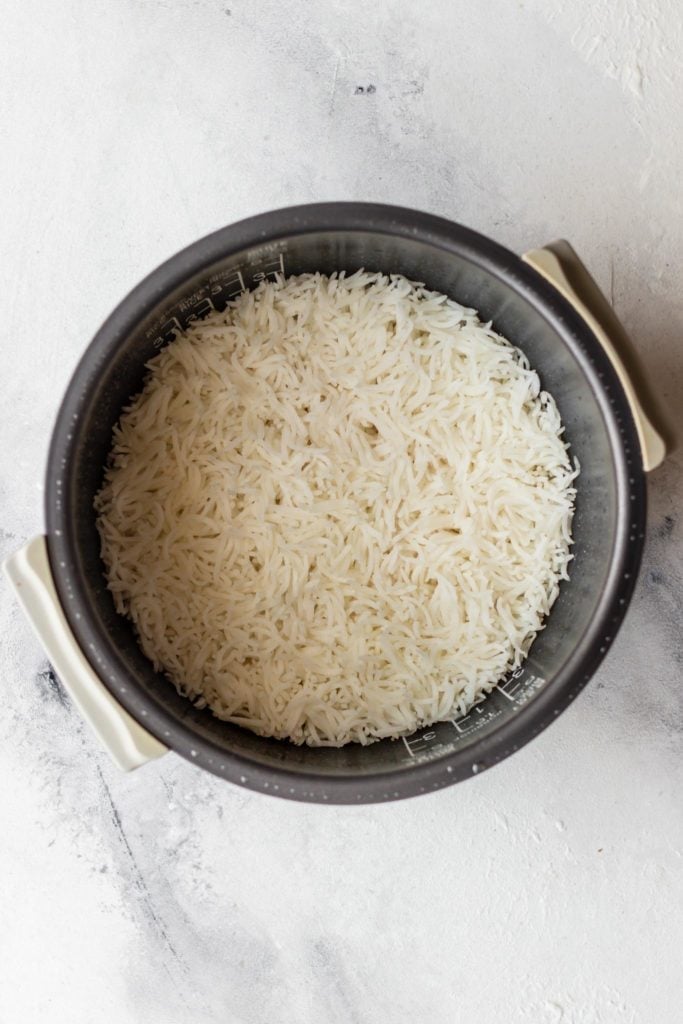
- Once finished cooking, fluff with a rice spatula/paddle and remove promptly to prevent the rice from getting mushy toward the bottom of the cooker.
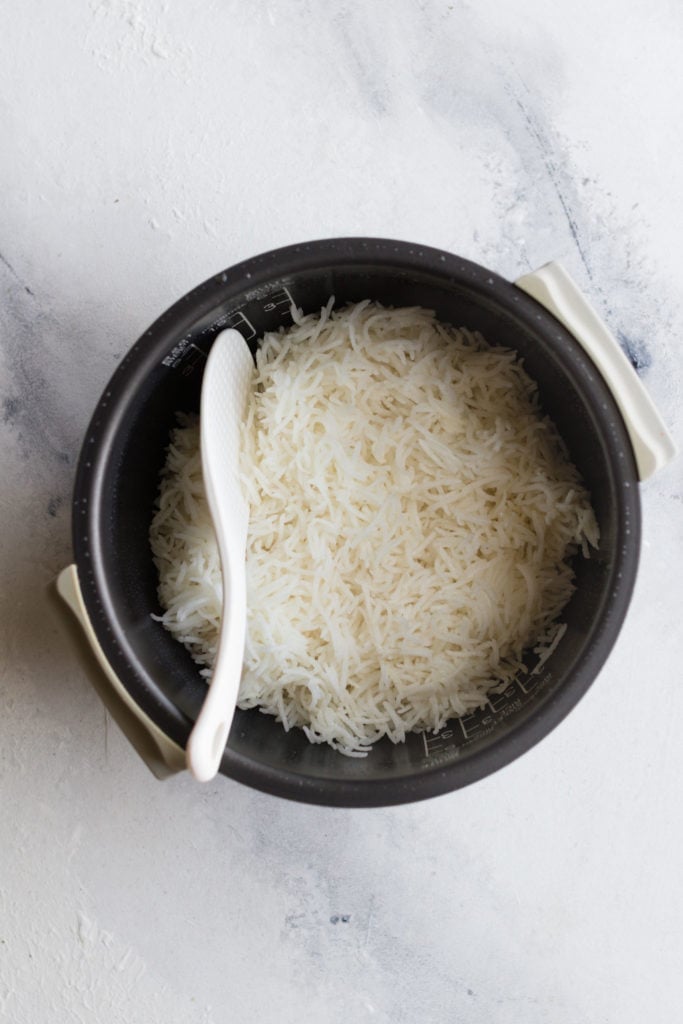
How To Cook Brown Basmati Rice In A Rice Cooker
If you’re using Indian or Pakistani grown brown basmati rice, increase the water ratio to 1 cup rice to 2 1/2 cups water.
If you’re using new, American-grown brown basmati rice, stick to 1 cup rice to 2 cups water.
How To Make Flavored Rice In A Rice Cooker
You can easily use this ratio and ingredients for variation:
- Add a handful of frozen peas and cumin seeds to make a quick Matar Pulao.
- Use this Chana Pulao (chickpea pilaf) or Chicken Pulao recipe to make the base in a sauté pan and transfer to the rice cooker.
- Use leftover curry or meat and enhance it with spices to make a fresh new pilaf with minimal effort.
Tips for making basmati rice in the rice cooker
- The rice at the bottom of the rice cooker naturally tends to be stickier, while the rice on the top is more dry. To prevent this, fluff with a rice paddle or spatula after cooking. If you cook a large quantity of rice and leave it in the rice cooker too long, it’ll stick together and form clumps.
- The cooking time will increase depending on the quantity of rice.
- To keep the rice from losing moisture or drying out, keep it covered after cooking.
- Use a quality brand of basmati rice. I suggest purchasing it at Indian or Pakistani grocery stores as it’s generally aged and more affordable there. I use Royal Chef’s Secret Extra Long Grain.
What brand rice cooker is best for basmati rice?
I love the Zojirushi brand. I have the Neuro-fuzzy and was recently sent the Micom NS-WTC10 (thanks, Zojirushi!). I found the Neuro-fuzzy to work a bit better than the Micom.
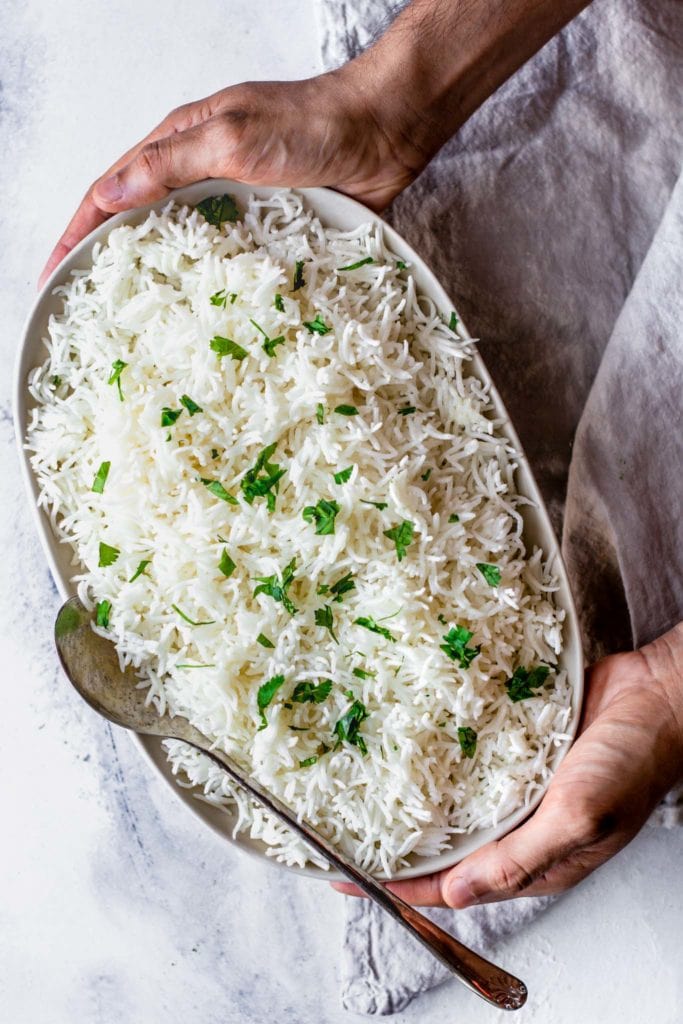
How to Store & Reheat Basmati Rice
- To store basmati rice, place in an airtight container in the refrigerator. You can also freeze it by laying it flat in an airtight plastic bag.
- To reheat, wet a paper towel, squeeze out the excess water, and lay atop the rice before microwaving. You can also sprinkle a bit of water on top of the rice and microwave until heated through.
Serving Suggestions
Basmati rice goes perfectly with almost all curries such as Dals, Masala-based curries like Chana Masala or a Chicken Curry, kebabs, and just about every main dish on this website. It is also great alongside fusion dishes like Spicy Cashew Chicken and Chicken Shashlik.
Need more ideas? Check out this roundup of 30+ Easy & Authentic Dinner Recipes to get inspired!
Tried this recipe? If you have a minute, please consider leaving a comment and/or a photo and telling me how it was! If you’re on Instagram, please tag me so I can see your creations. I truly love hearing from you. Thank you!
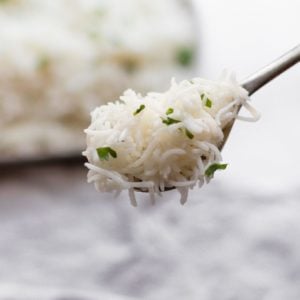
Perfect Basmati Rice in the Rice Cooker
Watch the Video
Ingredients
- 1 cup (185 g) aged, long grain basmati rice, brown or white
- 1 3/4 – 2 cups water* (See Note 1)
- 1 tbsp oil, any kind
- 3/4-1 tsp kosher salt, or to taste
Instructions
- Optional but recommended – Gently wash the rice to remove excess starch until the water runs mostly clear. Use a colander to drain well.
- Add the rice, water, oil, and salt to the rice cooker and stir to combine.
- Choose Normal (Regular/Sushi) Rice setting. For Brown rice, select Brown Rice Setting.
- Once finished cooking, fluff with a rice spatula/paddle and remove promptly to prevent the rice from getting mushy toward the bottom of the cooker. To keep the rice from losing moisture or drying out, keep it covered after cooking.


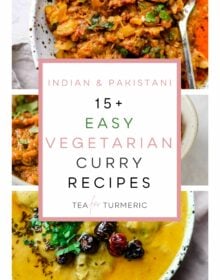
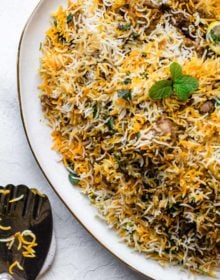
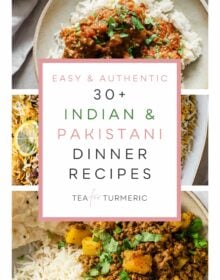

72 Comments on “Perfect Basmati Rice in a Rice Cooker (White and Brown)”
I had no idea how good basmati rice could be. I’ve tried different ways of cooking basmati rice–all tricky–and none of them turned out. Because of that, I stopped cooking basmati rice for years, until tonight. This recipe turned out perfect. The flavor is wonderful. It was so easy. Why have I never seen this before? I will start cooking basmati rice frequently. I love it!
Hi Roxanne, We are so happy to hear you found a recipe to make Basmati Rice for you! Thank you for sharing 🙂
I’m 79 and not a very talented cook however this is the most delicious rice I’ve ever made. Your recipe and instructions were clear and accurate. I used Mahatma Basmati White Rice imported from Pakistan and a Wolfgang Puck 10 Cup Electric Rice Cooker Model BDRC0010 which I haven’t used in many years. My ingredients were 3 cups of thoroughly washed rice, 5.25 cups of filtered water, 1 tbsp of kosher salt and 3 tbsp of Kirkland Grass-Fed Salted Butter imported from New Zealand. Adding olive oil or combining it with butter would have also been good and I’ll do that next time. It took 28 minutes to cook and truly was the Perfect Basmati Rice.
Thank you so much Barry! We are ecstatic to hear that you found it to be the Perfect Basmati Rcie 🙂
This recipe is perfect. I have a bag of Indian basmati rice that is kind of light brown. I’ve used it to make biryani. I was intimidated to try making it in the rice cooker. I followed the recipe exactly as was stated above. I used a small knob of butter for the oil. I used the salt grinder for the salt. But I measured the rice using a measuring cup and the same thing for the water.
The rice came out perfect! Flaky! delicate! The perfect balance for Indian/Pakistani dishes with delicious sauces. I couldn’t stop eating the rice.
Thank you, Ms. Cheema. Your recipe encouraged me so much.
Thank you for the wonderful comment Ron! We are so happy to hear the rice came out perfect 🙂
Hi Izzah! Can we make white rice in instant pot also?
Hey there! Trying this recipe tonight in my rice cooker. I have Indian brown basmati rice. I’m rinsing it but on my package instructions, it says to soak for 15 mins (under stove top instructions, didn’t come with rice cooker instructions). Would you soak? Or just rinse and cook in the rice cooker?
Soaking brown rice wouldn’t hurt but I don’t think it’s necessary when cooking in the rice cooker. I’ve cooked Indian brown basmati in the rice cooker without soaking plenty of times.
This is a great recipe, thank you so much. My first attempt wasn’t so great but then I read your note, since I was using rice imported from India I needed more water, and it turned out perfect the second time! I’m vegan and looking forward to trying some of your vegan options. Thanks again!
Thank you Melinda! We hope you enjoy the vegan recipes just as much 🙂